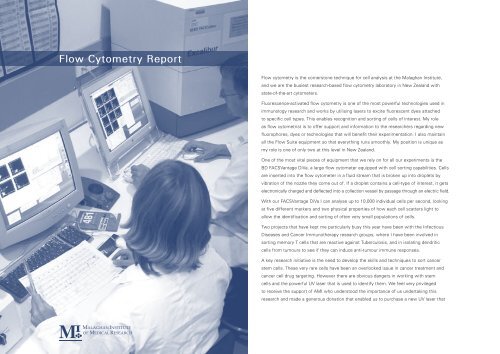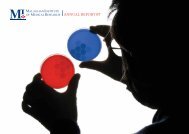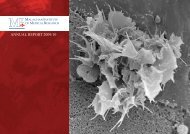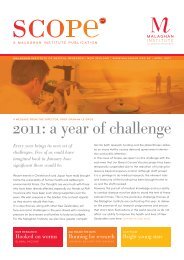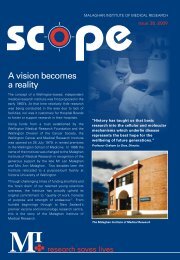Seminars - Malaghan Institute of Medical Research
Seminars - Malaghan Institute of Medical Research
Seminars - Malaghan Institute of Medical Research
Create successful ePaper yourself
Turn your PDF publications into a flip-book with our unique Google optimized e-Paper software.
Flow Cytometry Report<br />
Flow cytometry is the cornerstone technique for cell analysis at the <strong>Malaghan</strong> <strong>Institute</strong>,<br />
and we are the busiest research-based flow cytometry laboratory in New Zealand with<br />
state-<strong>of</strong>-the-art cytometers.<br />
Fluorescence-activated flow cytometry is one <strong>of</strong> the most powerful technologies used in<br />
immunology research and works by utilising lasers to excite fluorescent dyes attached<br />
to specific cell types. This enables recognition and sorting <strong>of</strong> cells <strong>of</strong> interest. My role<br />
as flow cytometrist is to <strong>of</strong>fer support and information to the researchers regarding new<br />
fluorophores, dyes or technologies that will benefit their experimentation. I also maintain<br />
all the Flow Suite equipment so that everything runs smoothly. My position is unique as<br />
my role is one <strong>of</strong> only two at this level in New Zealand.<br />
One <strong>of</strong> the most vital pieces <strong>of</strong> equipment that we rely on for all our experiments is the<br />
BD FACSVantage DiVa, a large flow cytometer equipped with cell sorting capabilities. Cells<br />
are inserted into the flow cytometer in a fluid stream that is broken up into droplets by<br />
vibration <strong>of</strong> the nozzle they come out <strong>of</strong>. If a droplet contains a cell-type <strong>of</strong> interest, it gets<br />
electronically charged and deflected into a collection vessel by passage through an electric field.<br />
With our FACSVantage DiVa I can analyse up to 10,000 individual cells per second, looking<br />
at five different markers and two physical properties <strong>of</strong> how each cell scatters light to<br />
allow the identification and sorting <strong>of</strong> <strong>of</strong>ten very small populations <strong>of</strong> cells.<br />
Two projects that have kept me particularly busy this year have been with the Infectious<br />
Diseases and Cancer Immunotherapy research groups, where I have been involved in<br />
sorting memory T cells that are reactive against Tuberculosis, and in isolating dendritic<br />
cells from tumours to see if they can induce anti-tumour immune responses.<br />
A key research initiative is the need to develop the skills and techniques to sort cancer<br />
stem cells. These very rare cells have been an overlooked issue in cancer treatment and<br />
cancer cell drug targeting. However there are obvious dangers in working with stem<br />
cells and the powerful UV laser that is used to identify them. We feel very privileged<br />
to receive the support <strong>of</strong> AMI who understood the importance <strong>of</strong> us undertaking this<br />
research and made a generous donation that enabled us to purchase a new UV laser that


